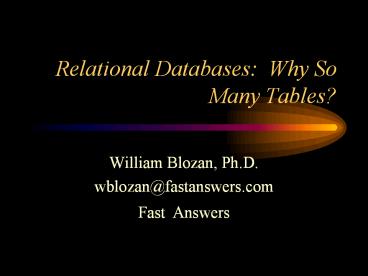Relational Databases: Why So Many Tables? - PowerPoint PPT Presentation
1 / 17
Title:
Relational Databases: Why So Many Tables?
Description:
Database Development: Programming, Data Theory & Business Management ... Understanding Relational Databases, Fabian Pascal, Wiley. Consultants. ... – PowerPoint PPT presentation
Number of Views:29
Avg rating:3.0/5.0
Title: Relational Databases: Why So Many Tables?
1
Relational Databases Why So Many Tables?
- William Blozan, Ph.D.
- wblozan_at_fastanswers.com
Fast Answers
2
Introduction
- Database Development Programming, Data Theory
Business Management - What is Relational Modeling?
- How Many Tables Do I Need, and Why so Many?
- This Topic Is of Interest to All Levels of
Database Developers.
3
Agenda
- Symptoms of Dysfunction
- The Challenge
- Whats at Stake
- Key Design Concepts
- Recommended Steps For Modeling Tables
- Additional Modeling Complexity
- Recommended Steps For Managing Tables
- Managing Table Complexity in the GUI
- Example
- Plan Initial Data Conversion
4
Symptoms of Dysfunction
- Insufficient Number of Fields.
- Multiple Entry of Data.
- Awkward Or Impossible Data Access.
- Frequent User Entry Errors Variations.
- High Maintenance Complexity
- Very Slow System Performance
- Unwieldy Change Management
5
Vocabulary
- Flat File Spreadsheets and Word Processors.0 (
misused RDBMSs) - Boyce-Codd Normalization The Theory is only 25
yrs old! - Object Modeling Conceptual Layer
- Relational Modeling Logical Layer
- DBMS Handles the Physical Layer
- Entity-Relationship Diagrams
6
The Challenge
- Seek To Design A Safe Data Repository
- Seek To Provide Easy Data Entry
- Seek To Provide Flexible Data Retrieval
- Must Allow for Repository Extensions
- Must Anticipate Additional Uses Users
- Seek Tolerable System Performance
7
Whats At Stake
- Stable Production System
- End User Direct Access
- Disaster Recovery
- Total Development Time Effort
- Data Conversion Complexity
8
Key Design Concepts
- Single Source Data Repository
- Application Independence
- Objects are Nouns Processes are Verbs
- Process Logs are Nouns
- Let the Data Speak!
- Claim Correct Model gt All Sensible Reports are
Feasible - Must be able to describe an Arbitrary Record
for each table
9
Recommended Steps For Modeling Tables
- Identify Primary Strategic Objects
- Each Object Becomes a Table
- Identify Multi-Valued Fields gt Each repeating
field can mean a Child Table - Identify M-M Relationships gt Each requires a
Third Association Table
10
Recommended Steps For Modeling Tables, Cont
- Identify each Data Processing Step
- Each process warrants at least one log table
- Consider Lookup Tables and Value Lists
- Consider Adding a System Table and an Audit Log
- Consider other Application Meta Data
- Multi-User Processes gt Temporary Tables may be
necessary to isolate processes
11
Additional Modeling Complexity
- Use Content-Void Primary Keys
- 1-1 Table Relationships Still Require a Parent
- Self Joins track genealogy
- Partial RI For Optional Foreign Keys
- Track Embedded Value Lists
- Using Cascade Delete
- Data Events gt Use Triggers
- Watch Out Time Order of Occurrence
12
Recommended Steps For Building Tables
- Finalize the Entity-Relationship Data Model
- Name Carefully tblNounAdjVerbAdverb
- Build the Tables and Relationships
- Use AutoNumbers as Primary Keys
- Add all data columns/fields
- Define Data Types, Column Sizes, Default Values,
Indexing, Validation, etc. - Add Audit Fields, Temporary Conversion Source
Fields
13
Manage Table Complexity In Screens And Code
- Start with Bound MS Access Forms
- Linked Tabs and Sub-Forms
- Zoom To Edit M-M Parents
- Bound, But Empty
- Events BU, AU, AI, On Current, Triggers
- Unbound Views Of Many Tables
14
Example Business Cards
- 1-7 Tables
- 2 Key Objects Firms People
- M-M Association Employee w/ Job Title
- Lookups Phone Type, Address Type
- Phones?, Addresses?
- gt One Screen Functionality Is Complex
- Unbound Form, Drop-Downs, Tricky Navigation
- Easy To Use gt Lots Of Code
15
Plan Initial Data Conversion
- Map Old To New, New To Old
- Spot Compacted Tables Extract
- Spot Compacted Fields Extract
- Check For Required Fields
- Check For Consistent Spelling of LUs
- Prepare Save Queries/Scripts
- Trap Source Tables Keys
16
Conclusion
- Get It Right From The Start
- OK, Then Fix It As Soon As You See It
- Name Things Appropriately
- Data Model Diagrams Aid Communication With
Clients and Colleagues - Suppress Complexity From Users
- Art or Science? Both!
17
Where to get more information
- Nothwind Traders Sort of!
- MS Access SQL Server User Groups
- Establish quid pro quo relationships
- MS Access has Analyzer wizards
- ERwin, Infomodeler, Visual Modeler
- Database Processing, Kroenke Dolan, SRA.
- Understanding Relational Databases, Fabian
Pascal, Wiley. - Consultants.































